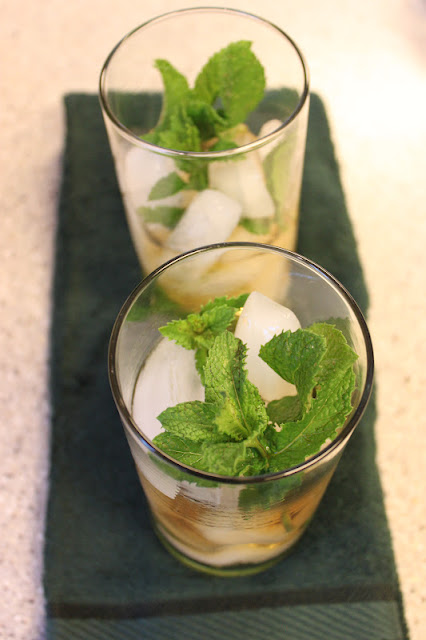Right now I'm in Cleveland, enjoying a week with family and quiet mornings of blazing heat. While I love Providence, it's wonderful to escape from a city (even a small one) for a time. I get to remember what it's like to walk down the street hearing only the cooing of birds and the rustle of wind through the trees.
Plus, there's nothing like spending holidays with family, the Fourth of July included. We spent yesterday morning with my aunt and uncle and cousins, enjoying the local parade (and trying to stay cool).
Then we escaped back to the dark, cool house and set to the important work of preparing the evening barbecue. And because I can never ignore an excuse to bake, I made kuchen tarts.
My sister Lissa just finished her first year of a master's program in art history, and she spent her June taking German to pass her language qualifications. She is now the German expert of the family, and she tells me that
kuchen (pronounced KU-khuhn, not KU-ken) means "cake" in German.
I made cake tarts!
There is absolutely nothing wrong or indulgent about that sentence.
(Lissa also speaks to me regularly in German. This is frustrating for two reasons:
1. I don't speak German, aside from the random phrases I've picked up from war movies. And
2. We used to speak to each other in Franglais, a broken form of French + English. She has left our Franglais behind for more exotic languages.)
Linguistic regrets aside, these tarts are amazing, as one might expect from something called "cake tarts."
They're made from a basic coffeecake-type dough, yeasty and sugary with a hint of nutmeg. Once you've let the dough rise, you can make all sorts of magical kuchen, from cakes filled with cinnamon and sugar to those filled with crushed poppy seeds and fried to perfection. Lissa tells me that modern kuchen aren't very much like those described in
The "Settlement" Cook Book, but hey, it was 1903. We're using recipes that came over from Germany back in the 1840s and 1850s.
The kuchen tarts I chose feature a dollop of jam in the middle, perfect for Fourth of July color-coordination. I alternated between strawberry and blueberry jam to make a red and blue theme. Sadly, some of the jam melted off the tarts in the oven.
Later I discovered that you're probably supposed to put the biscuits in a cake pan so they sort of meld together like pull-apart coffeecake. But those are the mistakes you make when you're working from old-fashioned, unclear recipes that say only "
place close together in a buttered pan."
But despite these drawbacks, the tarts were still delicious.
And my family only made a few jokes about the pronunciation of "kuchen."
Almost Kuchen Tarts
(adapted from
The "Settlement" Cook Book)
For the dough:
1 cup milk
1/4 cup unsalted butter
1/4 cup sugar
1/2 tsp salt
pinch of nutmeg
1 beaten egg yolk (save the white for another purpose)
2 1/4 tsp active dry yeast (or 1 package active dry yeast)
3 1/2 - 4 cups flour
For the filling:
1/2 cup your choice of jam (I used 1/4 cup blueberry and 1/4 cup strawberry)
Scald the milk over medium heat (this means to heat it until small bubbles form around the edge, then remove from heat). Let cool to lukewarm. In a small bowl, mix the yeast and 1/2 tsp of the sugar, plus 1/4 cup of the lukewarm milk. Set in a warm place to proof. (You'll know it's working when the mixture puffs up like a sponge.)
Meanwhile, add the butter, the rest of the sugar, the salt, and nutmeg to the rest of the milk in the pan. Stir in the beaten egg yolk. Add the proofed yeast mixture and combine thoroughly. Add the flour one cup at a time. You may only need 3 1/2 cups, but add as much flour as you need to make a smooth, elastic dough. Transfer the dough to a large bowl, cover, and let rise until doubled in bulk. (This usually takes about an hour, but if it's as hot as it was yesterday, it may only take twenty minutes.)
When the dough is ready, punch down and transfer to a floured board. Roll out the dough to about one inch thickness, and cut with a biscuit cutter. Place the biscuits on a buttered cookie sheet and let rise until light, about twenty minutes.
Meanwhile, preheat the oven to 425 F and set out the jam filling. When the biscuits have risen, poke a hole in the center of each biscuit and drop in a spoonful of jam. Once you've filled all the biscuits, bake at 425 F for 10 minutes. Reduce the heat to 350 F and bake for another 5-10 minutes, until browned.






















